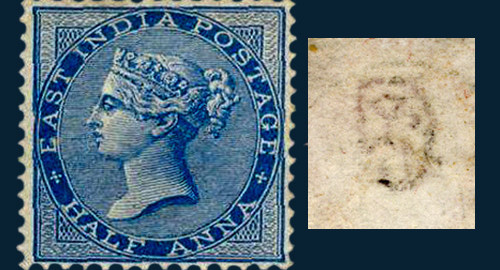

In this world of mobiles and computers the word letter or postcard has been outdated just like a box of old letters and postcard left forgotten in a corner of an attic. So is an old book of stamps with watermarks on them. Though stamp collecting seems a bit out of fashion, the hobby is back in a vogue since few decades and these little pieces of forgotten past are getting tremendous attention from the world.
Stamp is a tiny piece of paper stuck in a corner of a letter without which the letter has no value. This little paper piece has many stories to tell and many secrets to share. Apart from being the live evidences of history, stamps do have a hidden side unknown to many. This secret lies neither in denomination nor in the theme featured on it; it is in the paper itself.
So what is it?
A Watermark is a distinct and an important feature of stamps and is a challenging subject to the philatelists. A watermark is the only feature to distinguish a common stamp from a rare one. Over the time, postal agencies throughout the world have used watermarked papers as a security measure against counterfeiting. Watermarks are made during the paper manufacture process by intentionally impressing an image into the still-wet paper. Where the image is impressed, the paper is thinner and the image can be seen by holding the paper up to a light. Early stamps were generally printed on watermarked paper.
There have been countless different watermarks used worldwide since the first stamp was issued. In the countries such as Great Britain, a watermark is an inextricable feature of their entire postal history. Numerous types of watermarks appear on the British stamps. Being a part of the British Empire they appear on the stamps issued in the colonies also. India was no exception.
History of watermarks in India
Though Scinde Dawk Stamps paved the way of philately in India and the usage of postage stamps began, it took almost a decade for watermarks to appear on the stamps. The use of watermarks on stamps came into effect in 1865 marking a new chapter in Indian Philately. Since then, stamps have been marked by one or many hidden images which give testimony of the authenticity of the stamps.
Different Types of watermarks
A number of watermarks appear on the stamps of Pre – Independent India. Watermarks are found on Queen Victoria’s, the Edward VII, the George V, and the George VI stamps. Most interestingly, the Postal Stamps of Princely State of Cochin also bear unique watermarks.
The first ever watermark to appear on British stamp is the “Elephant’s Head”. The elephant continues to appear on the stamps of “East India Company”. This new set of stamps issued between 1865 and 1876 bore a portrait of Queen Victoria in an oval vignette inside a rectangular frame. Altogether, some 24 stamps were issued, all of which were watermarked by the Elephant’s Head.
The term East India Postage was changed to India Postage from 1882 onwards so did the watermark on it. A complete new set of stamps was issued with “India Postage” was inscribed on them. These stamps now had a “Star” watermark. Various frames and different colours marked each value.
New century came up with new stamps. In the second decade of the century a new series of stamps were issued with the portrait is King George – V. These stamps were more florid in their design. The watermark was changed for a third time in 1926 to showcase multiple stars.
But did you know that out of all the princely states only Cochin had watermarked its stamps?
The postal history of India is a boundless subject of study complicated with the melange of East India Postage, British Stamps and the Posts of Princely States prior to 1947. Many of the princely states had their own Postal Service and issued their own stamps marked by the influence of their culture and tradition.
Cochin was a small state on the South-west coast of India – presently known as Kerala. People of Cochin seem to have been fond of writing letters as the state have the most efficient postal system of the nation. Cochin postal system was an extraordinary one, so was its stamps. Mainly because, they were bilingual, displaying both Malayalam and English and they also bore various distinctive symbols and most importantly it was the only princely state to have its stamps watermarked.
Watermarks began to appear on Cochin stamps only after the first decade of 20th century. They come with two different watermarks. Initially an umbrella is seen as a watermark which, sometimes, may appear inverted. Umbrella watermark is distinct feature of stamps issued during 2nd and 3rd Maharaja of Cochin.
Later, the watermark was changed from the one umbrella to a large sheet watermark. This particular water mark is very unique and complex consisting typical symbols of the kingdom. Just like the stamps, this new watermark is also bilingual and the most sophisticated over. More interestingly, this watermark is bigger than the stamp itself. The stamps were normally printed on a sheet bearing this watermark. Hence, the stamps do not show the entire watermark but bits of it.
From elephant head to the sheet watermark of Cochin, pre – independence stamps of India show a fascinating and a sophisticated development of watermarks. Though small in numbers, these watermarks store a hidden treasure of knowledge. Get ready to unveil this mysterious side of the stamps!
So next time don’t forget to check the other side of the Stamp!
The Mintage World Team comprises of experts, researchers and writers from the field of Philately, Notaphily and Numismatics who try to shed light on some of the most interesting aspects of coins, banknotes and stamps from not just India but across the globe as well.
Looking like a Great specimen .
Mughal Stamps In India
Thanks.